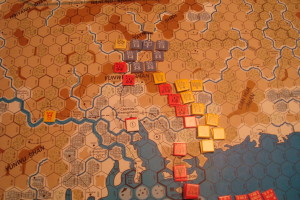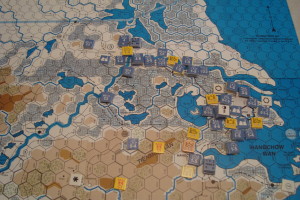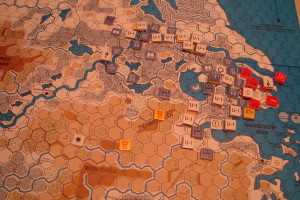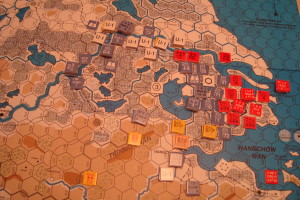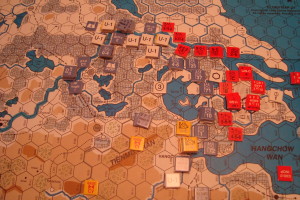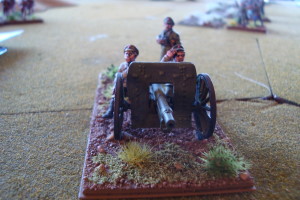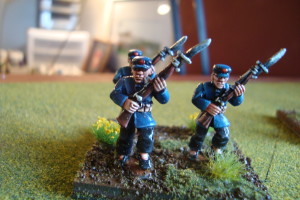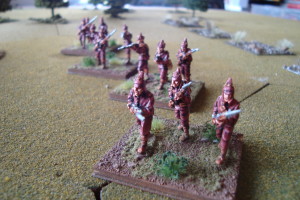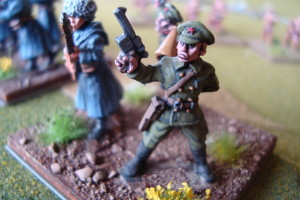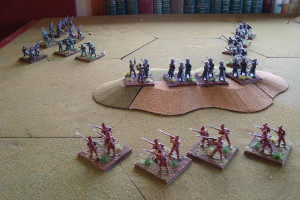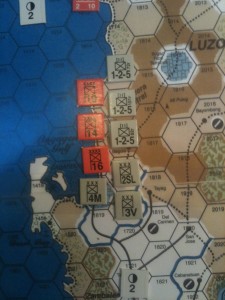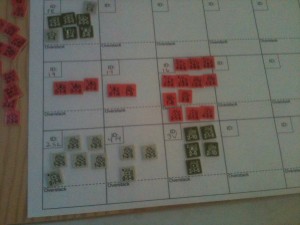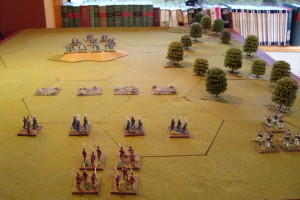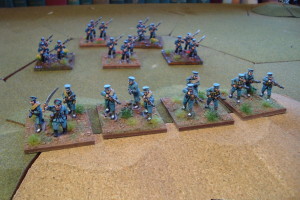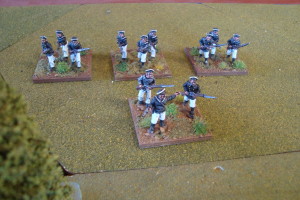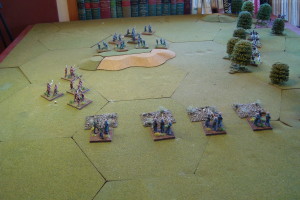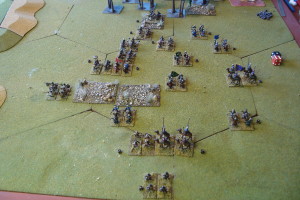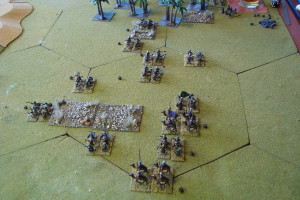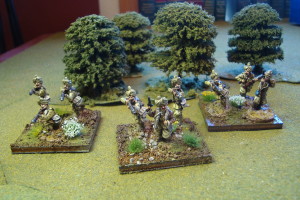Played through my first game of Stonewall: Battle of Kernstown. As stated in my previous post, this 1978 game was the second game to use the Terrible Swift Sword system developed by Richard Berg. The first game was a monster game of the Battle of Gettysburg entitled, strangely enough, Terrible Swift Sword.
While the system rules have gone through a number of permutations, here is quick and dirty overview of the basic rules for the first several games published by Simulations Publications Inc. Each game comes with its own special rules.
Turn Phase Sequence: Initial Command, Movement, Defensive Fire, Offensive Fire, Retreat Before Melee, Melee, Ammunition Resupply, Rally, Final Command.
Movement: Consistent rates for each unit type. Cavalry has mounted/unmounted; Artillery, limbered/unlimbered, Infantry, line/column.
Facing: Used and critical. Limits firing arc, zone of control (ZOC) and rear three hexes allow opponents to fire in enfilade.
Stacking: Limited to 8 strength points, with maximum of two units. Only top unit can fire, or take incoming small arms fire. Both units take incoming artillery fire. Both units count for melee, and both units are pinned when that combat result occurs. If top unit routs, second unit must roll for rout.
Fire Combat: Units can only be fired on once, firing units combine strengths. Artillery fires separately and at half strength against infantry. Line of sight rules are common sense, but beat to death in the rule book. Combat Results Table (CRT) uses firing strength points. Result are loss of strength, pin, or roll for rout.
Zones of Control (ZOC): Infantry, dismounted cavalry and artillery ZOCs extend to three frontal hexsides. Mounted cavalry all six. Supply wagons, and leaders none. Effect withdrawl fire, retreat fire, block both supply and command radius paths.
Withdrawl Fire: Takes place when unit leaves (typically retires before melee) a ZOC. Retreat fire occurs when a unit retreats into a unit’s ZOC.
Ammunition Supply: When small arms units roll to fire, either one (1) or six (6) die roll (depending on game) results in ammunition depletion. Unit cannot fire for rest of game unless re-supplied by a supply wagon (if available). Artillery units have a limited amount of ammunition. Hits on artillery units by other artillery units can explode cassions, resulting in ammunition depletion. Artillery batteries can redistribute ammunition. Infantry/Cavalry cannot.
Melee: Attacking unit ends movement phase in enemy ZOC. Takes fire, then advances into hex in melee phase. Melee CRT uses differential in strength points between units.
Rout: Based on morale rating. Three hexes, reduced movement and combat capabilities.
Rally: By leaders that are within their command radius. An expenditure of one rally rating point.
Brigade Combat Effectiveness (BCE): Each unit has a designated effectiveness strength. If it falls below that designated strength, it’s combat capabilities are dramatically reduced. BCEs are presented as a playing aide in the individual game rules.
Leadership: Units organized by brigade, with designated brigade commander. Brigade commander has an effectivenss rating, or hexes through which he can control his brigade, and a rally rating, which is used to rally units. One rally point rating automatically rallies one unit that is within its effectiveness rating. Divisional commanders have same ratings, but their effectiveness extends to their subordinates.
The game’s scenario is an interesting one. Jackson’s force is outnumbered, and has the mission of moving north from the south edge of the map. His three brigades can enter anywhere along the south edge of the map, east of (inclusive) of the turnpike. Objectives (for victory points) are securing a series of hills north of Kernstown, and/or exiting the map with as many units as possible.
The four Union brigades, while superior in strength, are spread out. An understrength cavalry brigade and an infantry brigade guards the river fords east of Kernstown, one brigade holds Pritchard’s Hill, which commands the town and turnpike providing a direct and rapid route for south-north movement, with another brigade in reserve near the north edge of the map. Here’s a link describing the historical battle.
Of course, I had to try something completely different and, as always, when given the opportunity, attempt to disregard at least one of the Principles of War. In this case, my most aggregious error was ignoring the principle of Mass.
I split the Confederate forces in three. The cavalry brigade was tasked to force the fords to the east, and make a run for the northern map edge. Garnett’s Brigade’s mission was to support the cavalry brigade to its right, force the fords immediately east of town, and advance along the turnpike placing pressure on the Union forces there. The remaining two Rebel brigades, along with Jackson, swung west of Kernstown (not has far west as historically) to outflank the forces on Pritchard’s Hill, to engage and destroy the northernmost Union force. Hopefully, the strong Union force on Pritchard’s Hill could be bypassed, and inflict minimal damage on the bypassing Confederate forces.
It was a Dog Fight.
The Confederate cavalry brigade wore down its weaker opponent, forcing the ford and eventually destroying the Union cavalry brigade. As ordered, it moved to the north.
Garnett’s Brigade engaged in a slugfest with its Union opponents east of Kernstown, forcing the ford, pinning them, while taking long range fire casualties from Pritchard’s Hill. Two Union regiments had the misfortune of suffering ammunition depletion on their very first turn! Resupply did occur, but the supply wagon was captured by the marauding Confederate cavalry brigade. Despite these mishaps, the Union forces stopped Garnett’s advance, with both sides suffering heavy casualties.
Jackson’s two brigade flanking force engaged elements of the Union’s reserve brigade which had moved south to prevent a flanking attack on Pritchard’s Hill. As this fight developed, the advancing Confederate forces were attacked in the flank by units from Pritchard’s Hill, barely beating off these attackers during the melee phase.
After these attacks, which disordered but failed to stop Jackson, the Union forces continued to hold Pritchard’s Hill, with the now depleted Union reserve units beginning a slow withdrawl to their original position, under some pressure from a beat-up Confederate force.
I didn’t go to the effort of counting up victory points, but I’m pretty sure this was, at least, a Union tactical victory.
More thoughts on the game and system in my next post. Have to set up Wilson’s Creek!
